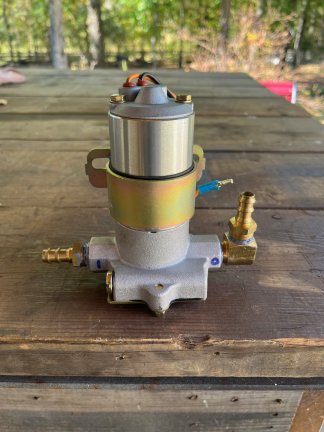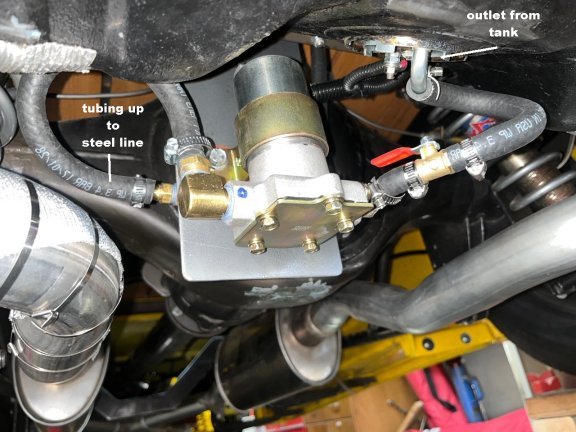|
A bunch of us have installed a mustang (or its equivalent) fuel tank behind the rear axle of our trucks. The modification has been around forever. Some did it to gain more room behind the seat in the cab or to get the gas smell and the sloshing sound out of the truck. Some did it cause it was a cool modification. |
| In a '53 the original tank was under the truck so I am in the cool group. I detailed the install in another article so you can find the how-to on my website. jniolon.classicpickup.com. It's an easy chore, taking less than a half a day and from day one worked as planned... |
| For the first few months all was well and the truck performed better than I had anticipated. Now, granted it was driven infrequently only when weather and time permitted. After that initial period the truck developed an intermittent problem of stumbling until it finally died leaving me stranded on the shoulder... only to start a few minutes later and run for an indeterminable amount of time where it would happen again. My first impression was that it might be ignition related. I had noticed that the volt meter showed less than 10 volts when I tried to restart the engine. The engine has a DUI electronic distributor which requires a minimum of 10 volts to fire the coil. I'd get a jump from someone and limp home and recharge the low battery, which usually showed 10-11 volts at shutoff. |
| The next test was like the first... run well...stumble and die...jump it off and limp home. I dug a little deeper and found that the one wire alternator was failing to charge the battery sufficiently. I installed a new alternator and enlarged the charging wire gauge to #4 gauge then did a battery test and it showed 13.9 volts after a charge. I tried again. Same problem. So, this time I pulled the battery and did a load test on it. While battery voltage was in the 'good' range the load test showed that battery couldn't hold up to the test using a 500 amp carbon pile tester. Voltage dropped off quickly and never recovered as it should. |
| The Wal-Mart special (I hate Wal-Mart ) was replaced with an Optima Red Top. I was a little gun shy by this time and the next test was a long neighborhood and surrounding area cruise... all good. I was happy. The next outing ... the problem reoccurred ALTHOUGH this trip included surface and interstate roads...just like the first two fails. I realized that the problem only happened when driving on freeway at 60-75 mph... never on surface roads @ 35-45 mph. Well, that light bulb moment confused me even more until I explained my problem to my mentor/guru and he suspected a fuel delivery problem...maybe a fuel filter blockage or trash in the tank or a bad fuel pump. I changed the filter and drained the tank and scoped it ...it was perfectly clean. We checked the fuel flow beyond the filter but before the fuel pump and we had some flow (emphasis on some). We added pressure to the tank and flow increased so we ruled out blockages in tank or lines to that point so we moved further down the line to the fuel pump. |
| We set up a
fuel pump test... fed the carb from a canister above the carb with a
rubber hose and attached a rubber hose to the output of the fuel
pump and we had some flow (there is that word 'some' again. So for
now we ruled out fuel pump and the carb itself. More thinking ensued. We were still fairly sure we had a fuel problem. When it was running it ran great...no ignition problems showed up. When all this started the tank was a little over half full...maybe 12-14 gallons. I pumped it dry to scope the tank that filled two 5 gallons cans and a part of the third.. After checking the tank I refilled it with the partial can and one full 5 gallon can. (to save all that time draining if I had to do it again) |
| Another test
after that and problem was still there. When it happened I
coasted to the side of the freeway and raised the hood and looked
for something that might have happened that we missed. I
looked at the carb site glasses and they showed no fuel in the
bowls. Shook the truck and nothing showed. Looked in the
carb and the squirters weren't squirting. The carb was
dry. After getting back home I hooked up with my guru and told him
what I found. His light bulb came on and he told me the carb
was starving at speed when the engines needs more gas. It's
still a fuel flow problem.
|
| We went back over everything and I even diagrammed the fuel route. The tank sits low in the frame and the outlet is on the bottom of the front side. I used rubber line from the tank outlet up to the steel fuel line in the frame rail ...it's an 8" rise. Then a straight shot thru cutoff and filter to the front end where I used flexible braided SS line from the steel line to the fuel pump...then the same braided line to carb inlets. So, there is an 8" rise between tank outlet and the fuel pump. That's a pretty good hill to climb for gravity feed. |
|
|
| After a lot of discussion and cussin, (He is so much smarter than me...he spends as much time teaching me what I don't know as he does solving the problem...I should learn to stop arguing with him.) We came to the conclusion that the mechanical pump couldn't lift the fuel that much. Which didn't explain why it ran on surface roads (lower speeds) but not on freeways (Higher speeds AND higher fuel consumption) I called two or three fuel pump mfgs. and asked what the vacuum draw was on their mechanical pumps. Not a one of them knew...they just said 'it's pretty good'. More discussion and cussin and we decided our low speed cruisin combined with turns and hills and valleys sloshed around enough fuel to keep the engine fed at low speed. Also the weight of the fuel itself forced the fuel up that 8" rise BUT as the fuel level dropped so did the pressure created by the weight of the fuel in the tank and less and less push in the tank. Remember?? I only refilled the tank with 7-8 gallons of fuel ?? I never had the problem with a full tank... full tank = more pressure in the line to overcome the 8" rise. When we were cruising at 75 on the interstate (much less sloshing of gas...no stops, starts or sharp curves.. just 10 miles of smooth highway) the weight of the half full tank couldn't overcome the rise, so it starved the engine (proof was the empty fuel bowls) |
| Now...the
fix. We added a Holley Sniper street electric pump at the
outlet of the tank.. which had enough pull - plus gravity) to work
and push the fuel up the rise to the steel line. It's a 96 gph pump
with regulated fuel pressure at 7 psi +/-. We added a
regulator inline and cranked it down to about 3.5-4 psi for the
demon carb. I left the mechanical pump inline to avoid all the replumbing. There are other cheaper pumps to be had. Some called click-clack pumps that would probably work but internet reviews showed a pretty high failure rate... more $$ usually means better and a proven name brand gives a little more confidence. Another factor was I didn't want to do this again when the cheaper pump failed in the future. |
|
|
| We tried the test again and it performed flawlessly...longer runs with higher (and lower) speeds and not a skip or stumble was felt. I'm much more confident now. I'm not 'puckered up' when I get a few miles from home. My only complaint is that the pump is noisy. |
| I still plan
on adding an oil pressure cutoff switch for the pump which will shut
off the pump when the oil pressure drops. That way pump isn't
running and deadheading when the engine isn't running but the
ignition is on. Parts are on the brown truck. I'm also adding an inertia
switch to cut pump in case of an accident.
|
|
|
| This problem/fix probably won't apply to anyone but me... Murphy has a way of giving me unusual/difficult to solve problems, but there are lots of mustang tank users that might run into this someday. |
|
Boilerplate denial of liability statement… i.e. the fine print This installation is something I did to put parts of MY truck together. It is not patented, engineered or even perfect… it is what it is, a home done install/repair/solution. I’m sure there are alternatives to this design some even better/cheaper/easier, I just didn’t think of them or warrant them necessary... there are several similar units on the internet waiting behind Google for you to see/copy/build…(just like I did) This work was done by me and for me or by friends who were nice enough to help me out. I only ask that if you reproduce it give me credit for it and if you make money from it… give me my percentage. Since I have no way of knowing your level of competence, welding or cutting skills, mechanical ability or estimated intelligence, there are no guaranties or warranties either verbal, written or implied with this article. Along with this article I am giving you absolutely free of charge…that’s right ! FREE !!...the liability, total and complete liability for the use or misuse of this contraption (and installation method) will be yours and yours alone. It belongs to you and keep that in mind… I am in no way responsible for any damage, injury or embarrassment or ridicule you may suffer from the use of my ideas or my methods. If it doesn’t look like something you’d be comfortable doing… don’t do/use it. If you’re not intelligent enough to make that decision about your comfort level… ask a family member or friend.. but here’s a hint… if you have to ask someone… don’t do it ! Pictures were made at different stages of construction and all assemblies in pictures may not be complete in each shot. I.e.. a picture showing ‘some parts’ only means that it was not finished, but I’ve tried to make the idea complete to the best of my ability. If you have questions or see mistakes or problems, let me know by e-mail and I’ll make the corrections if possible.. Use these ideas at your own risk. Modify them at your discretion and to suit your purpose. Your mileage may vary, batteries not included, much assembly required... wait one hour after building to enter the water, additional charges may apply. not all applicants will qualify for advertised A.P.R., for ages 10 to adult…side effects are comparable to placebos. Do not take drugs when building or operating machinery. JUST SAY NO. Copyright . 2023 John Niolon, All International Rights Reserved. This document may not be copied or published without prior written consent of the author- jniolon@att.net |


